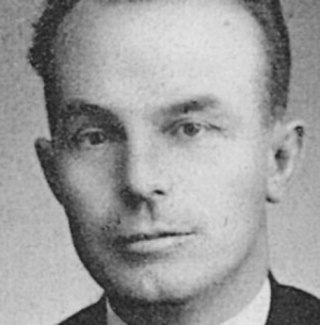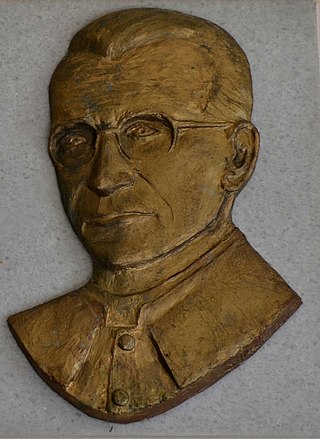
Stefan Wincenty Frelichowski was a Polish Roman Catholic priest. He was part of the scouts and was affiliated with several other groups during the course of his ecclesial education though maintained strong links to these groups after his ordination to the priesthood. He was arrested not long after World War II began and the Gestapo moved him to several concentration camps before sending him to Dachau where he died from disease.

Anton Durcovici was a Romanian prelate of the Roman Catholic Church and the Bishop of Iași from 1947 until his death. Durcovici was a victim of Romania's Communist regime, under which he was imprisoned; he died while in jail. He was known for being a zealous bishop who visited each parish within the confines of his diocese and known for his efforts in preaching the Gospel to all that he could. He likewise was known for his staunch commitment to the values of the Gospel and for his allegiance to the Church which led to his false arrest and imprisonment at the hands of the communist regime. Durcovici was a professor of seminarians and taught his students subjects such as canon law. His zeal as a priest led to his appointment in Bucharest as a rector for seminarians and his renown in Romania led to his episcopal appointment as a bishop.

Baron Vilmos Apor de Altorja was a Hungarian Roman Catholic prelate, born as a baron in the noble Apor family, and served as a bishop during World War II. He became famous for protesting against the persecution of the Hungarian Jewish population and for his steadfast commitment to the poor. His outreach also extended to abuse victims with a particular emphasis on the protection of women - it would be this latter commitment that saw him sustain fatal injuries leading to his death. Apor dedicated himself to being an opponent of both communism and Nazism and used his sermons as a platform to condemn them though coming at a great personal risk to himself. Apor was a beloved figure in his diocese, where people hailed him as a great saint upon learning of his death.

Shtjefën Kurti was an Albanian Roman Catholic priest killed during a period of communist persecution. Kurti served as a priest during a volatile period for his nation in which communist repression led to strict rules being imposed that prevented clerics from performing their duties. Kurti continued to function as a priest when required which saw him arrested with the accusation that he was colluding with spies. Kurti was arrested for the final time when it had been alleged that he secretly baptized a child which was forbidden by the regime. He was sentenced to death and executed by firing squad.

János Scheffler was a Hungarian-born Roman Catholic prelate who served as the bishop of two dioceses before acting as the Bishop of Oradea Mare. He was imprisoned due to opposing the Communist government policies and was killed while imprisoned. He had been noted during his episcopate for his attentiveness to vocations and for the defense of the faith from those forces that sought to disrupt it such as communism.

Jakob Gapp was an Austrian Roman Catholic priest and a professed member from the Marianists. Gapp first served as a soldier on the Italian front during World War I at a point in his life where his religious convictions were not of high importance, though his return home from a prisoner of war camp saw him develop socialist views that soon bought him into contact with the Marianists whom he later joined. After studies and ordination he was assigned in Austria as a teacher, where he became noted for his vehement opposition to the Nazi regime; he deemed Nazism as being some warped political tool to create division which was also incompatible with the faith.

The Priest Barracks of Dachau Concentration incarcerated clergy who had opposed the Nazi regime of Adolf Hitler. From December 1940, Berlin ordered the transfer of clerical prisoners held at other camps, and Dachau became the centre for imprisonment of clergymen. Of a total of 2,720 clerics recorded as imprisoned at Dachau some 2,579 were Roman Catholics. Among the other denominations, there were 109 Protestants, 22 Orthodox, 8 Old Catholics and Mariavites and 2 Muslims. Members of the Catholic Society of Jesus (Jesuits) were the largest group among the incarcerated clergy at Dachau.

Otto Neururer was an Austrian Roman Catholic priest and was the first priest to die in a Nazi concentration camp. Neururer did his studies for the priesthood in Brixen before he served as a teacher and pastor in several cities before settling in 1932 in Götzens near Innsbruck. He was arrested in 1938 for attempting to persuade a girl not to be wed to a man of questionable morals and was sent to Dachau before being transferred to Buchenwald where he died after being hanged upside down, nailed to a tree, practically crucified. As he was "crucified" he did not scream, but instead prayed silently. He was left there for 36 hours and then killed by Nazi guard Martin Sommer. Otto Neururer was later beatified.

Gerhard Hirschfelder was a German Roman Catholic priest. He was a vocal critic of Nazism and used his sermons to condemn Nazi propaganda and other aspects of Nazism which drew suspicion on him from the authorities who monitored him and even interrogated him on occasion. He was a staunch supporter of the role of adolescents in the life of the Church and made them a focus in his pastoral activities. In his imprisonment he became a member of the Schoenstatt Movement.

Giuseppe Girotti was an Italian Roman Catholic priest and a professed member from the Order of Preachers. He served as a biblical scholar on both the Book of Wisdom and the Book of Isaiah and served as a professor of theological studies prior to World War II where he worked to aid Jewish people and to shield them from the Nazi Holocaust. But the priest was arrested in 1944 and moved from prison to prison before being imprisoned at the Dachau concentration camp where he befriended Josef Beran and Carlo Manziana.

Miroslav Bulešić was a Roman Catholic Croatian priest. He studied in Rome before being recalled to his native Istria where he was ordained in 1943 during World War II prior to two parish postings where he became a vocal critic of Communism. He renewed his parishes through well-organized pastoral activities and was a promoter of frequent sacramental reception. But his criticism of Communism saw him make enemies who soon set upon and succeeded in killing him.

Michał Kozal was a Polish Roman Catholic bishop. Kozal was noted for his intelligence and dedication to studies and studied to become a priest during World War I, which disrupted his studies but did not prevent his ordination in 1918; he gained fame for his abilities and rose to several positions that superiors endowed upon him all culminating in being named a Monsignor in 1932 and then appointed to the episcopate in 1939 just before World War II started. But his pastoral mission as a bishop did not last long since the Nazi forces arrested and tortured him and sent him to Dachau where he died after being injected with a lethal substance.

Odoardo Focherini was an Italian Roman Catholic journalist. He issued false documents to Jews during World War II in order for them to escape the Nazi regime but was arrested and sent to a concentration camp where he later died. Yad Vashem later recognized him as a Righteous Among the Nations in 1969 for his efforts.

Nicolò Rusca was an Italian priest who served in the Diocese of Como. Rusca was arrested under false pretenses and was killed through the use of torture in 1618. He was recognized by the Roman Catholic Church as a martyr and was beatified in 2013.
Pedro Asúa Mendía was a Spanish Roman Catholic priest and engineer. He studied under the Jesuits and he trained also as an architect. He graduated in that field in 1915. He worked on schools and houses for religious across Spain where he served as a priest. He was killed in hatred of his faith during the Spanish Civil War.

Engelmar Unzeitig, born Hubert Unzeitig, was a German Roman Catholic priest who died in the Dachau Concentration Camp during World War II on the charge of being a priest. He was a professed member of the Missionary Order of Mariannhill and assumed the religious name Engelmar when he was admitted into the order. He became known as the "Angel of Dachau".

Marcel Callo was a French Roman Catholic from Rennes who served in Catholic organizations – in particular the Young Christian Workers (Jocists) – devoted to charitable works to the poor and to communities in general. Callo served as an apprentice at a print store from the age of thirteen before joining Catholic associations in France. He was conscripted to serve during World War II and the Gestapo arrested him in 1944 for his Christian activities. He died in the camps after being forced to do long hours of labour.
Pierre-René Rogue was a French Roman Catholic priest and a professed member of the Congregation of the Mission – also known as the "Vincentians". Rogue exercised his pastoral duties in his hometown of Vannes and was known for his short stature and devotion to the faith. He was killed after he refused to take the oath of allegiance to the new French government. The townsfolk of Vannes nicknamed him "the wee priest" due to his short stature.

Titus Zeman was a Slovak Roman Catholic priest and a professed member of the Salesians of Don Bosco. Zeman studied in Italian cities prior to his ordination and worked in Slovakia to protect fellow Salesians after the communist regime outlawed religious orders. He was arrested after attempting to send Salesians out of the nation and was imprisoned from 1952 until 1964 and died due to poor health sustained from the prison conditions. He has been acclaimed as a defender of religious liberties.

Alojs Andritzki was a German Roman Catholic priest who suffered martyrdom in the Dachau Concentration Camp in 1943. He was ordained as a priest just prior to the beginning of World War II in which he became a vocal critic of the Nazi regime and its actions; this earned him their ire and he was arrested before being sent to the Dachau concentration camp where he was administered a lethal injection.


















